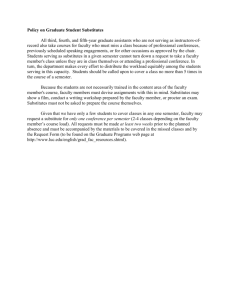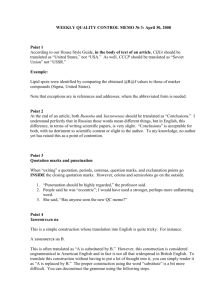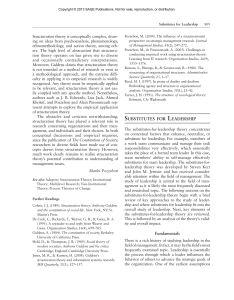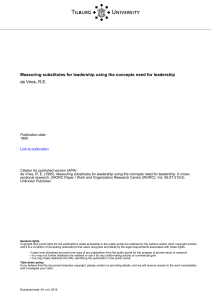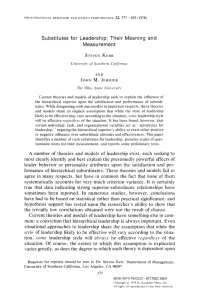Substitutes for Leadership Theory: Implications for University
advertisement
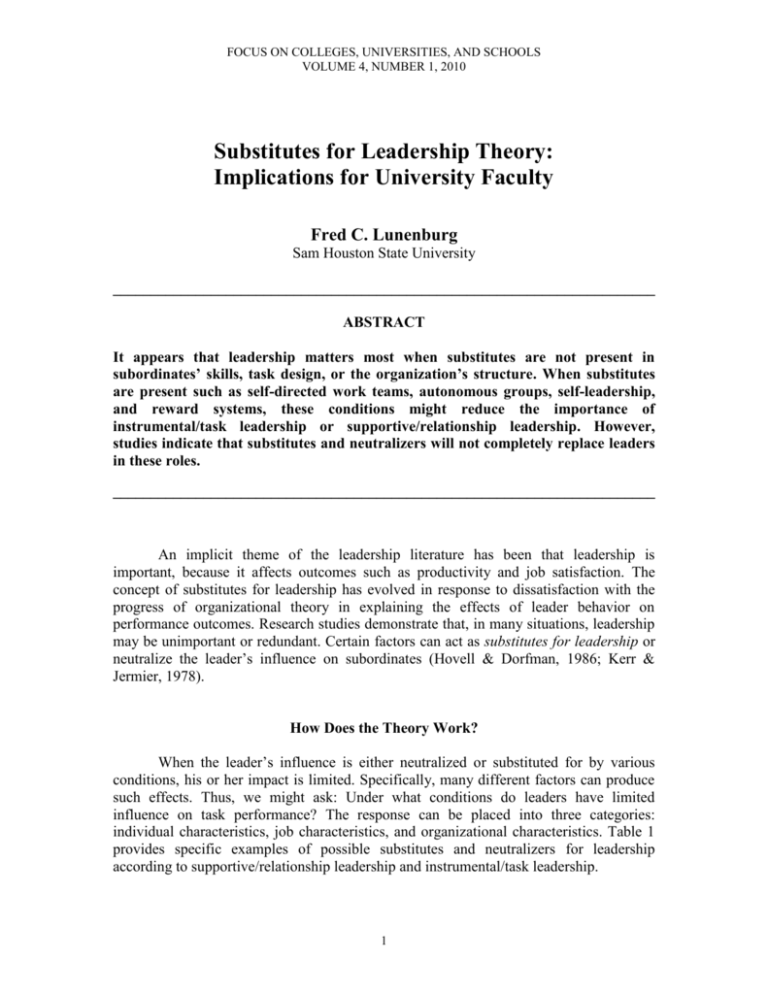
FOCUS ON COLLEGES, UNIVERSITIES, AND SCHOOLS VOLUME 4, NUMBER 1, 2010 Substitutes for Leadership Theory: Implications for University Faculty Fred C. Lunenburg Sam Houston State University ________________________________________________________________________ ABSTRACT It appears that leadership matters most when substitutes are not present in subordinates’ skills, task design, or the organization’s structure. When substitutes are present such as self-directed work teams, autonomous groups, self-leadership, and reward systems, these conditions might reduce the importance of instrumental/task leadership or supportive/relationship leadership. However, studies indicate that substitutes and neutralizers will not completely replace leaders in these roles. ________________________________________________________________________ An implicit theme of the leadership literature has been that leadership is important, because it affects outcomes such as productivity and job satisfaction. The concept of substitutes for leadership has evolved in response to dissatisfaction with the progress of organizational theory in explaining the effects of leader behavior on performance outcomes. Research studies demonstrate that, in many situations, leadership may be unimportant or redundant. Certain factors can act as substitutes for leadership or neutralize the leader’s influence on subordinates (Hovell & Dorfman, 1986; Kerr & Jermier, 1978). How Does the Theory Work? When the leader’s influence is either neutralized or substituted for by various conditions, his or her impact is limited. Specifically, many different factors can produce such effects. Thus, we might ask: Under what conditions do leaders have limited influence on task performance? The response can be placed into three categories: individual characteristics, job characteristics, and organizational characteristics. Table 1 provides specific examples of possible substitutes and neutralizers for leadership according to supportive/relationship leadership and instrumental/task leadership. 1 FOCUS ON COLLEGES, UNIVERSITIES, AND SCHOOLS 2_____________________________________________________________________________________ Table 1 Substitutes and Neutralizers for Supportive and Instrumental Leadership Factor Individual Characteristics 1. Experience, ability, training 2. “Professional” orientation 3. Indifference toward organizational rewards Job Characteristics 1. Structured, routine task 2. Task feedback 3. Intrinsically satisfying task Organizational Characteristics 1. Cohesive work group 2. Leader lacks position power 3. Formalization of goals and plans 4. Rigid rules and procedures 5. Physical distance between leader and subordinates Supportive/Relationship Leadership Instrumental/Task Leadership Substitute Substitute Substitute Neutralizer Neutralizer Substitute Substitute Substitute Substitute Neutralizer Neutralizer Substitute Neutralizer Substitute Neutralizer Neutralizer Individual Characteristics As shown in Table 1, subordinate experience, ability, and training may substitute for instrumental/task leadership. For example, professionals such as university professors may have so much experience, ability, and training that they do not need instrumental/task leadership to perform well and be satisfied. Typically, university professors are intelligent and skilled, and have a high level of intrinsic motivation. Employees who are intrinsically motivated enjoy their job and perform it well for its own sake (Latham, 2012). Their intrinsic motivation and capabilities ensure that they perform at a high level. Instrumental/task leadership acts would be redundant and might be resented, and could even lead to reduced performance (Schriesheim, 1997). Job Characteristics Certain types of work (for example, university teaching) are highly structured and automatically provide feedback (through student’s oral and written responses) and, therefore, substitute for instrumental/task leadership. Similarly, subordinates who have a strong professional orientation (like university professors) might not require instrumental/task or supportive/relationship leadership. Most university professors find their work to be interesting and intrinsically satisfying. This contributes to their high performance and job satisfaction. It is not necessary for their supervisor to push them to FRED C. LUNENBURG _____________________________________________________________________________________3 perform, attempt to keep them happy, or see them on a regular basis (Remedios, 2012). Their intrinsic motivation and capabilities serve as substitutes for both instrumental/task leadership and supportive/relationship leadership. When subordinates do not desire the rewards a leader can provide, this would neutralize almost any behavior on the part of the leader (Podsakoff & MacKenzie, 1997). Organizational Characteristics When the organization is structured in a way that makes clear the paths to goalsfor example, through plans, rules, policies, and standard operating procedures-such structure reduces the need for instrumental/task leadership. This is particularly apparent in socio-technical and autonomous work groups found in academic departments on university campuses. Various work norms and strong feelings of cohesion among faculty members in academic departments may affect job performance directly and render instrumental/task leadership and supportive/relationship leadership unnecessary. The cohesive work group of faculty members will exert its own influence over group members (Loughry, 2002). Moreover, the technology associated with certain jobs may determine the actions of professionals performing them, and, therefore, make the leader’s input unnecessary (Boss, 2007). Sometimes a strong union has the same effect, if it has a collective bargaining agreement that severely constrains the leader’s position power (Carrell, 2010). Implications The substitutes for leadership theory provides some opportunities for a better understanding of leadership in organizations (Colquitt, LePine, & Wesson, 2011). The substitutes theory is an attempt to point out that some variables are beyond the leader’s control. It may be used to explain why a leader who is perceived to be highly effective does not seem to make a difference in unit outcomes. The situation plays a role. The leader’s work context may possess high levels of neutralizers and substitutes. For example, substitutes for leadership may be very functional for self-directed (or autonomous) work groups such as academic departments in a university setting (Hamilton 2010; Schuster, 2009). In such cases, the substitutes have positive effects on the performance and organizational commitment of employees. The positive effects of the substitutes is sometimes greater than the positive influence of the leader. Some leadership experts recommend that leaders create high levels of substitutes in their work units, which may eventually lead to self-directed work teams (Manz & Neck, 2004; McShane & Von Glinow, 2010). Despite the existence of substitutes for leadership, however, research suggests that leaders do make a difference and can have positive effects on the attitudes and behaviors of their followers (George & Jones, 2008; Podsakoff & MacKenzie, 1997; Dionne, Yammarino, Atwater, James, 2002, 2005). FOCUS ON COLLEGES, UNIVERSITIES, AND SCHOOLS 4_____________________________________________________________________________________ Conclusion It appears that leadership matters most when substitutes are not present in subordinates’ skills, task design, or the organization’s structure. When substitutes are present such as self-directed work teams, autonomous groups, self-leadership, and some reward systems, these conditions might reduce the importance of instrumental/task leadership or supportive/relationship leadership, but they will not completely replace leaders in these roles. References Boss, J. M. (200&. Academic scientists at work. New York, NY: Springer. Carrell, M. R. (2010). Labor relations and collective bargaining. Upper Saddle River, NJ: Prentice Hall. Colquitt, J. A., LePine, J. A., & Wesson, M. J. (2011). Organizational behavior: Improving performance and commitment in the workplace. New York, NY: McGraw-Hill. Dionne, S. D., Yammarino, F. J., Atwater, L. E., & James, L. R. (2002). Neutralizing substitutes for leadership theory: Leadership effects and common-source bias. Journal of Applied Psychology, 87(3), 454-464. Dionne, S. D., Yammarino, F. J., Atwater, L. E., & James, L. R. (2005). Substitutes for leadership, or not. Leadership Quarterly, 16(1), 169-193. George, J. M., & Jones, G. R. (2008). Understanding and managing organizational behavior. Upper Saddle River, NJ: Prentice Hall. Hamilton, N. W. (2010). The future of the professoriate: Academic freedom, peer review, and shared governance. Washington, DC: Association of American Colleges and Universities. Hovell, P., & Dorfman, P. W. (1986). Leadership substitutes for leadership among professional and nonprofessional workers. Journal of Applied Behavioral Science, 22, 29-46. Kerr, S., & Jermier, J. M. (1978). Substitutes for leadership: Their meaning and measurement. Organizational Behavior and Human Performance, 22, 375-403. Latham, G. P. (2012). Work motivation: History, theory, research, and practice. Thousand Oaks, CA: Sage. Loughry, M. L. (2002, April). Co-workers are watching: Performance implications of peer monitoring. Paper presented at the annual meeting of the Academy of Management Association, New York, NY. Manz, C. C., & Neck, C. (2004). Mastering self-leadership (3rd ed.). Upper Saddle River, NJ: Prentice Hall. McShane, S. L., & Von Glinow, M. A. (2010). Organizational behavior. New York, NY: McGraw-Hill. FRED C. LUNENBURG _____________________________________________________________________________________5 Podsakoff, P. M., & MacKenzie, S. B. (1997). Kerr and Jermier’s substitutes for leadership model: Background, empirical assessment, and suggestions for future research. Leadership Quarterly, 8, 117-132. Remedios, R. (2012). Understanding psychological theories of motivation. New York, NY: Taylor & Francis. Schriesheim, C. A. (1997). Substitutes-for-leadership theory: development and basic concepts. Leadership Quarterly, 8, 103-108. Schuster, J. (2009). The American faculty: The restructuring of academic work and careers. Baltimore, MD: Johns Hopkins University Press.
